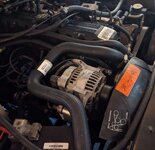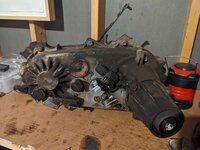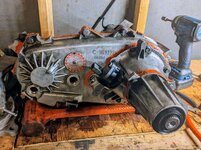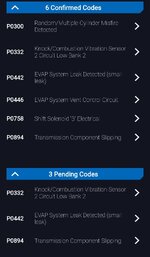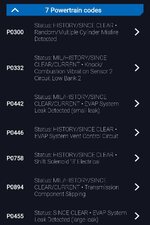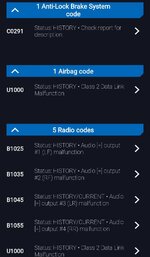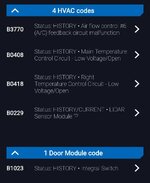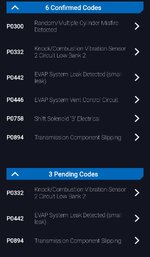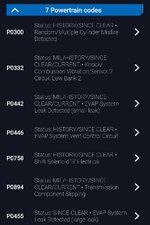After getting
@Gazeebo's recommendation, I did some additional research on OBD2 scan tools in order to find one for under $100 USD that would help me the most. I'll break them into three price categories:
basic (under $30),
mid-range ($31 - $69), and
high-end ($70 - $120). There are many tools above this price range that I did not research or consider.
Because of the diversity of manufacturer specific coding for various systems on their vehicle besides the engine, there is no one tool that will have the same feature set for every vehicle in its ability to read, clear and program codes.
I watched a few helpful videos that I've listed and I'm also pasting in some scan tool jargon at the bottom.
BASIC scan tools have simple abilities to read and erase codes, but that might be all you need in order to diagnose and repair. Many of these can not read oxygen sensor or EVAP codes, nor do they have live data.
Motopower MP69033 $20
Large font is easy to read as well as the B/W screen being visible in sunlight, but it did not find tranny fault in Honda Civic.
Autel MaxiScan MS309 $25
Gazeebo has two of these and they serve him well. It has a B/W display that is easy to read in the sunlight and it has a 12 month warranty.
User manual
Ancel 310 $28
B/W display is easy to read in the sunlight, but there is lots of lag for button depress to next display. It can graph data.
Bluetooth dongle scanners under $30
There are some cheap bluetooth dongle scanners available that people online say work well and give lots of info, but I did not research any particular ones in this price range because I'm just too gun shy of cheap Chinese stuff to have bothered.
MID-RANGE scan tools have larger displays, often in color (which is more difficult to see in the sunlight), and more buttons for convenience, as well as live data and freeze frame. It's at this price point that you get more sensor reading ability, especially for the O2 (oxygen) sensor, EVAP, etc. It's also at this price point where the tool is expected to be able to turn off the check engine light (MIL).
Autel AutoLink AL329 $36
First sold in 2012 and updated from AL319 to AL329, which can automatically retrieve VINs.
2.4" TFT color display (220 x 176 dpi), speaker, LED indicator, 12 month warranty
Foxwell 201 $40
Has O2 sensor, the software can be updated and the display is difficult to see in sunlight.
CGSULIT SC204 $40
In addition to the basics, it has EVAP, O2 and was recommended by Scotty.
Ancel AD410 $45
2.4 TFT color display (that is difficult to see in sunlight), live data stream, O2 sensor, processes codes quickly, spells out all the info, can graph data, but the software can not be updated. Also available in packages with additional features.
HIGH-END One of the interesting features you can get in the high-end is integrated testing electrodes for checking batteries and other electrical components.
Autel AutoLink AL439 $70
Electrical testing tool, TFT color display (220 x 176 dpi), has O2 monitor test, DTC help, print data via Windows PC, and does NOT have auto-VIN retrieval.
Foxwell NT301 $70
Provides useful information about trouble codes, can read the O2 sensor, software can be updated, 2.8" TFT display is difficult to see in sunlight, and has an additional mini-USB connector.
BlueDriver $80 (list prices is $120)
Bluetooth dongle, no wires, app & updates are free. Provides the most information of all the scan tools I looked at. Some of the most useful information that it has, which others do not, are for recalls and technical service bulletins, in addition to a database of repairs and Amazon links. You do have to create a minimal account and verify your e-mail address in order to use the app. The benefit for this is that your vehicle information is saved online in addition to it being saved locally on the app, as well as being printable and shareable on your other devices.
VIDEOS
PROJECT FARM - Best OBD 2 Code Scanner? Are All The Same? Let's Find Out!, May 2024.
This was my favorite video for a few reasons, including the fact that he made two graphics that compared all the features of the scan tools that he tested.

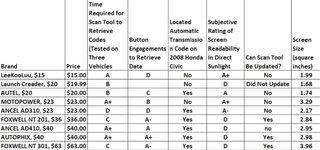 CHRIS FIX - The Best OBD2 Check Engine Light Scan Tool for the Money (Reads ABS, Airbag, Tranny Codes)
CHRIS FIX - The Best OBD2 Check Engine Light Scan Tool for the Money (Reads ABS, Airbag, Tranny Codes), Feb. 2015.
This is a good overview of the BlueDriver OBD2 scan tool.
SCOTTY - If You Don’t Have This Cheap Tool, You’re Stupid, Feb. 2023
Scotty reviews a few units at different prices points as only he can do.
SCAN TOOL JARGON from wikipedia
OBD On-board diagnostics
DTC Diagnose trouble codes
PID parameter IDs are live data streams
OBD-II PIDs (On-board diagnostics Parameter IDs) are codes used to request data from a vehicle, used as a diagnostic tool.
MIL means malfunction indicator light or check engine light. Not all tools can turn this off.
I/M Readiness, a key term in OBD-II scanner terminology, refers to the status of a vehicle's onboard diagnostic system regarding its preparedness for an emissions inspection, aka smog test.
Unidirectional means that the scan tool only receives information from the car's computers, with the exception of being able to clear codes. All the devices listed here are unidirectional.
Bidirectional means the scan tool can interact with the car's computers and issue commands, such as causing the EGR valve to activate, the fuel pump to initiate, or the ABS to bleed. These can also program the car's computers. Only the much more expensive devices are bidirectional.
SAE standard
J1979 defines many OBD-II PIDs. All on-road vehicles and trucks sold in North America are required to support a subset of these codes, primarily for state mandated emissions inspections. Manufacturers also define additional PIDs specific to their vehicles. Though not mandated, many motorcycles also support OBD-II PIDs.
Each DTC fault code is made up of five characters: a single letter followed by four numbers. The letter denotes which of the four main systems the fault has been detected in:
P: Powertrain
B: Body
C: Chassis
N: Network
The second character is a number that specifies whether it's a generic OBD-II code or a manufacturer code. (Manufacturers reserve the right to generate their own codes if there isn't a generic code for a specific problem they'd like drivers and techs to be able to diagnose.)
0: Standardized (SAE) fault codes
1: Manufacturer-specific codes
The third character is either a letter or number that specifies which of the vehicle systems is throwing a fault:
0: Fuel and air metering and auxiliary emissions controls
1: Fuel and air metering
2: Fuel and air metering (specific injector circuit)
3: Ignition systems or misfires
4: Auxiliary emission controls
5: Vehicle speed control and idle control systems
7, 8, 9: Transmission and gearbox faults
A, B, C: Hybrid propulsion systems
The fourth and fifth numbers denote the specific fault being detected. It can be any number between zero and 99.
Almost all modern OBD-II scanners will summarize the error code alongside the five-character alphanumeric code. Some of the more advanced models even have a code lookup function that will further explain the details of the fault and what might be causing it.
In the case of the Bluetooth OBD-II scanners, the apps might include video explainers (pulled from YouTube) that will show you how to further diagnose the code and possibly even repair the faulty components responsible for the problem.
#scanner
